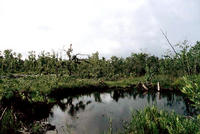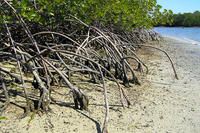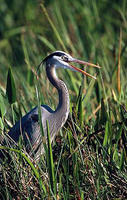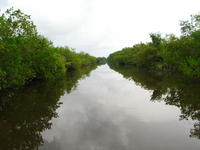You are in: North America -> United States of America -> Everglades National Park, and traditional search or Image Gallery will yield results of this site only
Everglades National Park
| Site number: | 76 |
|
| Type of site: | Natural Heritage in danger | |
| Date: | - | |
| Date of Inscription: | 1979 | |
| Location: | North America, USA, State of Florida, Southern tip of the Florida peninsula, Gulf of Mexico | |
Up to 75 images are shown here. Click on each for more details or on Image Gallery for more images.
| Description: | Lying on Florida’s southern tip, the site has been called 'a river of grass flowing imperceptibly from the hinterland into the sea'. A vast amount of birds and reptiles as well as some threatened species (such as the manatee) have made a sanctuary here due to the incomparable variety of the site’s water habitats. --WHMNet paraphrase from the description at WHC Site, where additional information is available. | |
| Everglades National Park is the largest subtropical wilderness in the United States. It contains the southern 25% of the original Everglades, and receives about a million visitors annually. It is the third largest national park in the lower 48 states after Death Valley National Park and Yellowstone National Park. Unlike most other national parks in the United States, Everglades National Park was created to protect a fragile ecosystem, as opposed to safeguarding a geographic feature. It has been declared an International Biosphere Reserve, a World Heritage Site, and a Wetland of International Importance. There are 36 federally threatened or protected species that exist within park boundaries that include the Florida panther, American crocodile, and West Indian manatee. Everglades National Park protects the largest wilderness area east of the Mississippi River. The water system of all of South Florida is dependent upon Everglades National Park to recharge the fresh water to the region, as well as to the Biscayne Aquifer. It is the most significant breeding ground for tropical wading birds in North America, and it contains the largest mangrove ecosystem in the Western Hemisphere. There are over 350 species of birds that live within Everglades National Park, as well as 300 species of fresh and saltwater fish, 40 mammals, and 50 different kinds of reptiles. The Everglades is a slow moving system of rivers, flowing southwest about a quarter of a mile a day, fed by the Kissimmee River and Lake Okeechobee. Although people have lived in the Everglades for thousands of years, since 1848 people have tried to drain the Everglades for agricultural or residential use, and control the water flow from Lake Okeechobee, diverting it to metropolitan areas in Miami-Dade, Broward, and Palm Beach Counties. The ecosystems in the Everglades National Park have suffered significantly due to human actions, and the repair and restoration of the Everglades is a politically charged issue in South Florida. It was listed as a UNESCO World Heritage Site on October 24, 1979 and as a Wetland of International Importance on June 4, 1987. --Wikipedia. Text is available under the Creative Commons Attribution-ShareAlike License. | ||
| Source: | http://whc.unesco.org/en/list/76 | |
| Source2: | http://whc.unesco.org/en/list/76/video | |
| Reference: | 1. UNESCO World Heritage Center, Site Page. | |



































